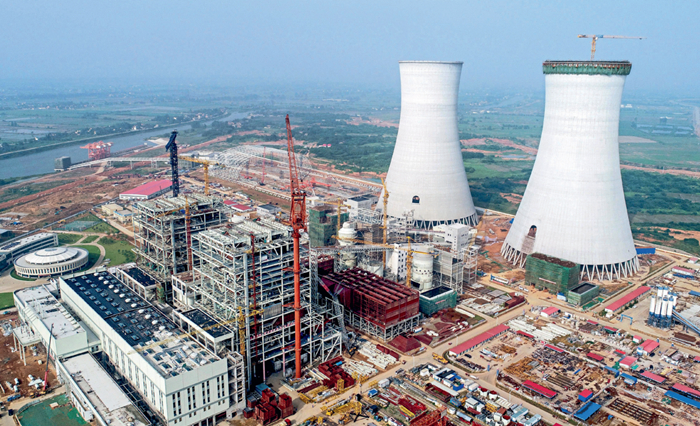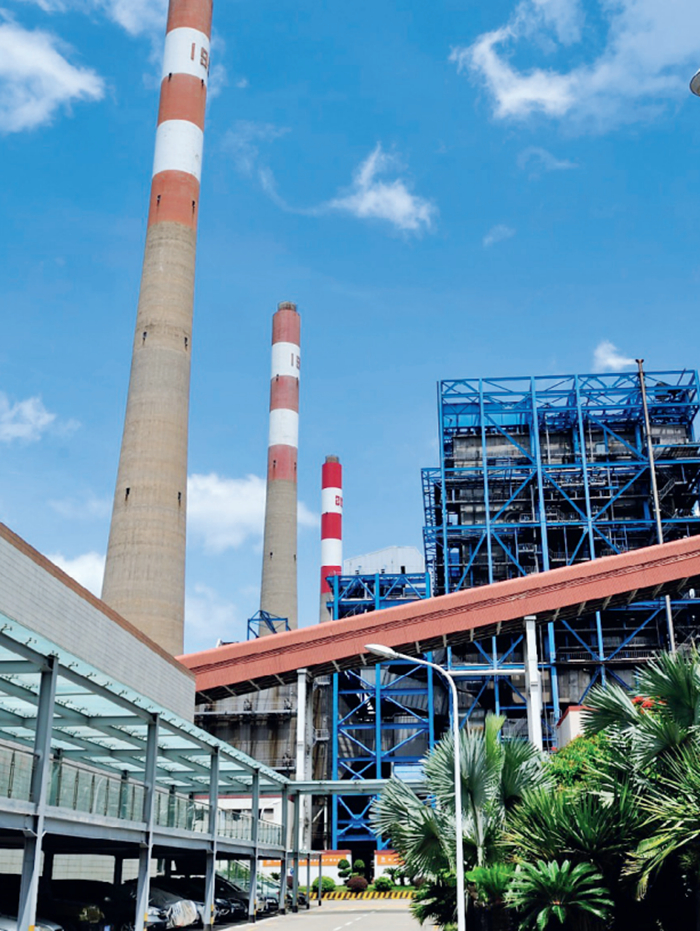|
||||||||||
| Home Nation World Business Opinion Lifestyle ChinAfrica Multimedia Columnists Documents Special Reports |
|
||||||||||
| Home Nation World Business Opinion Lifestyle ChinAfrica Multimedia Columnists Documents Special Reports |
| ChinAfrica |
| Coal Plants Get a Makeover |
| China upgrades coal-fired power generating units to reduce carbon emissions |
| By Ge Lijun 丨VOL. 14 JUNE 2022 ·2022-06-13 |

A coal power plant with low carbon emission is being built in Hefei, Anhui Province, on June 23, 2018 (CNSPHOTO)
Coal-fired power plants in China are attempting to shed their reputation as major polluters. A heating supply project undertaken by the Lingwu Coal-Fired Power Plant was able to replace 465 small boilers dispersed across Yinchuan, the capital of the Ningxia Hui Autonomous Region, thanks to improved technology. As a result, the city’s air quality has greatly improved. It’s one of the coal-fired power plants in China going through pollution-reduction renovation.
Reduction in the use of coal, heating system upgrade and flexible power generation of coal power plants are all part of China’s efforts of upgrading its coal-fired power plants. The country aims to upgrade coal-fired power plants with installed capacity of about 220 million kw this year in order to promote clean and low-carbon growth. According to the National Energy Administration (NEA), this will increase investment of nearly 50 billion yuan ($7.4 billion), save more than 10 million tons of coal, and encourage the consumption and utilization capacity of new energy by more than 30 million kw.
Ecological transition
Coal is China’s main source of energy, and plays an important role in maintaining the country’s long-term energy and power security, said Yu Bing, Vice Director of the NEA, at a symposium on the subject on April 24.
According to Lin Boqiang, Researcher at the Tan Kah Kee Innovation Laboratory and Dean of the China Institute for Studies in Energy Policy at Xiamen University, China accounts for half of the world’s coal-based electricity generation and its coal-fired power plants are among the world’s most efficient. Some coal-fired power plants have only been in use for around 10 years and are still in good operation conditions, which should not be decommissioned, but should be used in a more scientific way. “What we need to do is to upgrade the existing coal-fired power generation units, and allow them the flexibility to generate electricity during peak hours of power consumption, among other things, so as to support China’s low-carbon transition,” he told ChinAfrica.
According to the NEA, the average amount of coal used to produce electricity in China is about 305 grams per kwh, ranking first internationally; but there are still coal-fired power generation units in operation with installed capacity of 400 million kw, which use greater amount of coal and need to be upgraded as soon as possible.
“Flexible use of electricity generated by coal-fired power plants can better support the development of renewable energy, because renewable energy supply is unstable. It can help ensure stability of power supply, and also reduce costs for enterprises,” Lin pointed out.
The innovation of coal-fired power generation facilities was put on the agenda in 2021, when the National Development and Reform Commission and the NEA jointly issued a plan. According to the plan, coal-fired power plants, with combined installed capacity of over 350 million kw, will be upgraded to reduce carbon emissions during the 14th Five-Year Plan (2021-25), heating supply facilities with capacity of 50 million kw will be renovated, and 200 million kw coal-fired power generation facilities will be allocated for flexible purposes.
China has been working on this for some years, according to Yu. By the end of 2021, China has established ultra-low-emission coal-fired power generation units of more than 1 billion kw, including nearly 900 million kw of energy-saving retrofits and more than 100 million kw of flexibility retrofits. Since the 13th Five-Year Plan (2016-20), coal-fired power generation units emit less than 10 percent of China’s total air pollutants, such as soot, nitrogen oxides and sulfur dioxide. The country has built the world’s largest clean coal-fired power supply system.

A clean coal power plant of Shenzhen Energy Corp. in Shenzhen, Guangdong Province (VCG)
Strong financial support
Though China has advanced technologies for coal-fired power plant innovation, a shortage of finance is preventing policies from being fully implemented.
The renovation project of Unit 3 of China Resources Xuzhou Power Plant began in April 2017 with an investment of 350 million yuan ($52 million). But where did the funding come from? According to China Resources Xuzhou Power Plant, the firm had to fund the restoration on its own owing to a lack of bank lending at the time. For a long time, technology has not been an issue for businesses; what they have been lacking is money.
“Coal-fired power plants are now unprofitable due to rising coal prices. So, this type of large-scale retrofit requires government funding, as well as other financial support measures,” Lin remarked.
To ease the financing difficulties, the authorities have taken relevant measures. On November 17, 2021, the Executive Meeting of the State Council decided to set up a relending scheme worth 200 billion yuan ($29.46 billion) to support clean and efficient coal use. On May 4, the People’s Bank of China, the central bank, increased the targeted relending quota for the coal industry by 100 billion yuan ($14.73 billion), specifically to support coal development and utilization, and improve coal reserve capacity.
Financial firms are also increasing their contributions. At the symposium, Dai Lian, Deputy General Manager of the Financing Business Department of the Industrial and Commercial Bank of China (ICBC), stated, “At the end of March, ICBC extended outstanding loans totaling 250.2 billion yuan ($36.85 billion) for the thermal power business, up 3.1 percent over the same period last year.”
Dai suggested businesses pick financial services wisely and make proper use of the central bank’s monetary policies. In terms of enterprise-government-bank collaboration, she recommended aligning projects, policies, and financial needs, as well as identifying and resolving challenges to cooperation in a timely way.
“In any case, the government should take into consideration the whole situation, both about the realization of the renovation and the difficulties of the enterprises in the coal industry,” Lin told ChinAfrica.
|
||||||||||||
| About Us | Contact Us | Advertise with Us | Subscribe |
| Copyright Beijing Review All rights reserved 京ICP备08005356号-5 京公网安备110102005860号 |